Hunted: Mining Colony 415 is part of the Hunted line designed by Gabe Barrett. The Hunted games are designed for solo or 2-player cooperative play and utilize a single flexible rules system. Each specific title then has its own setting and unique mechanics.
In the case of Mining Colony 415, the setting is the titular space base. Sadly, your crew has arrived only to discover that the mining camp has been overrun by murderous extraterrestrials. (Fans of the Alien franchise will get the gist immediately.) You’ll have to be sharp if you want to escape with your life!
The Hungry and the Hunted
The games in the Hunted series share the same core gameplay. Each game comes with 2 decks: a Hunted deck and a Location deck. The goal is to advance through the former in order to reach a certain Location near the bottom of the latter. This must be done quickly and efficiently to preserve the player’s resources: Health, Time, and Ammo. If a player runs out of health or time, or has no ammo available during a combat, they lose the game.
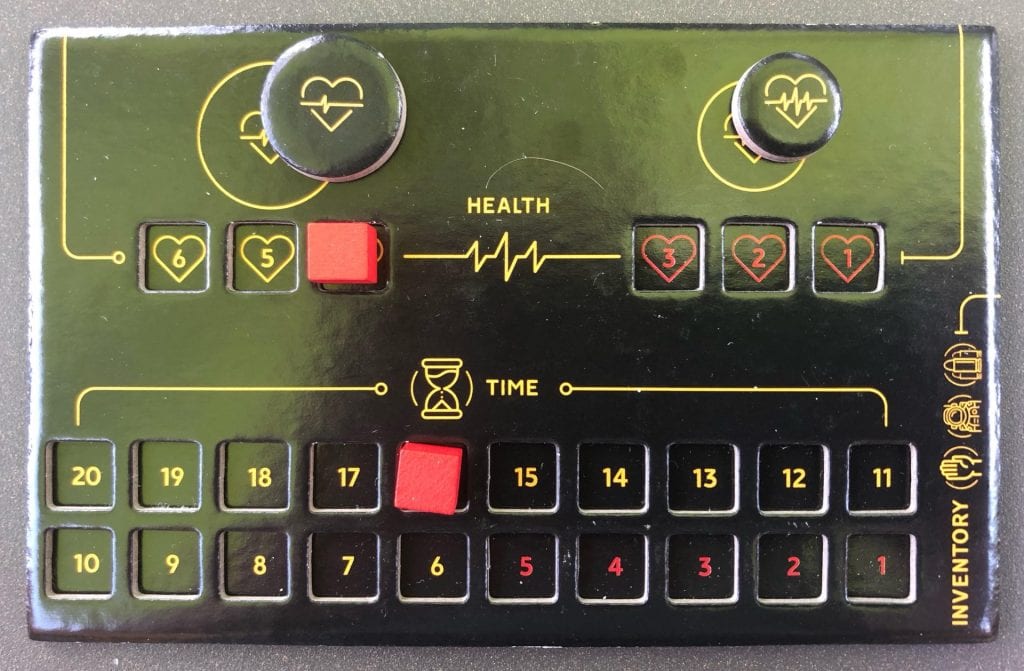
Navigating the Hunted deck is straightforward. On the player’s turn, they’ll flip the top card of the deck and place it in the Hunted row. Most cards have a variety of symbols in their upper-left corner as well as their bottom-right. Cards can be discarded from the row to “spend” the symbols in the upper-left in order to “buy” cards for the cost found in the bottom-right. Purchased cards might have an immediate effect or go to the player’s inventory for later use.
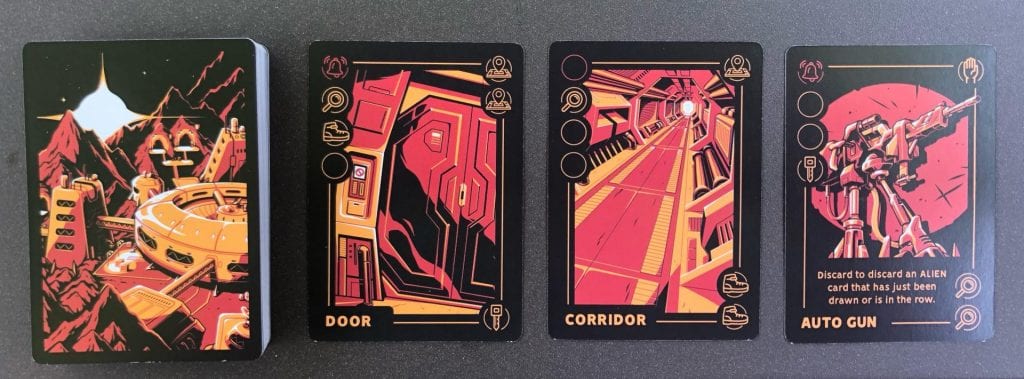
One immediate effect allows the player to reveal a new card from the Location deck. This is how the player advances through the game. Near the bottom of this second deck is the end-goal Location; when the player reveals this card they must complete a final challenge to win. The other Location cards have events which trigger when revealed that can impact the player. Many of these events offer a gain of resources on a success and a loss of resources on a failure.
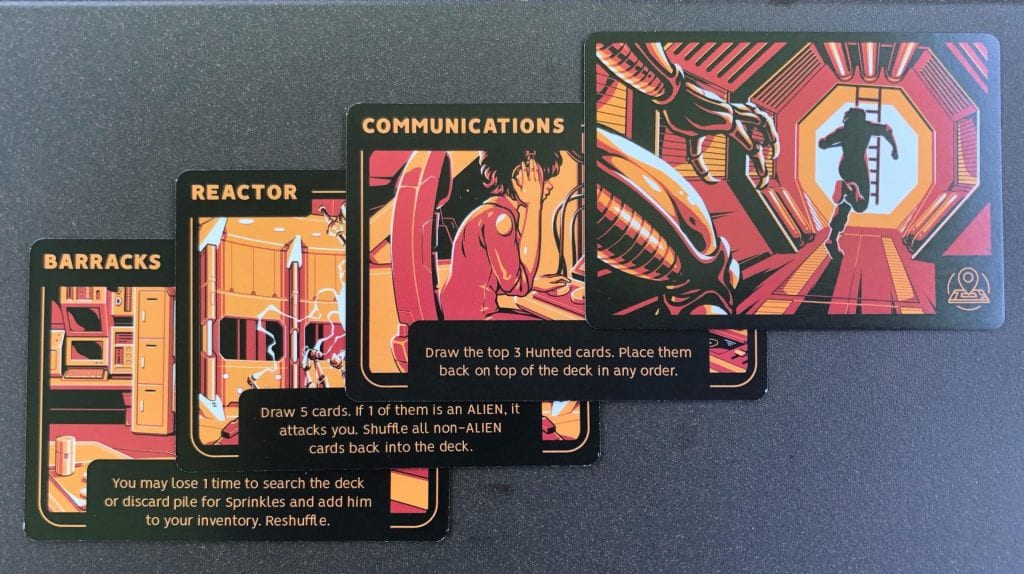
The Hunted deck also contains straightforward event-type cards — which generally require an immediate test using the title’s unique mechanic — as well as enemies. Enemies come in varying strengths and must be fought once activated. An enemy will activate under 2 possible circumstances: if a second enemy is placed in the Hunted row, the stronger one will activate; or if there are at least 2 “bell” icons and an enemy showing across all cards currently in the row. Whenever an enemy activates, all other cards in the row are discarded and the player must fight the enemy. A player may choose to pay 1 Time to Hide on their turn, discarding the entire row instead of flipping a new Hunted card. This allows the player to eliminate possible threats before they can activate (either by discarding inactive enemies or cards with bell icons).
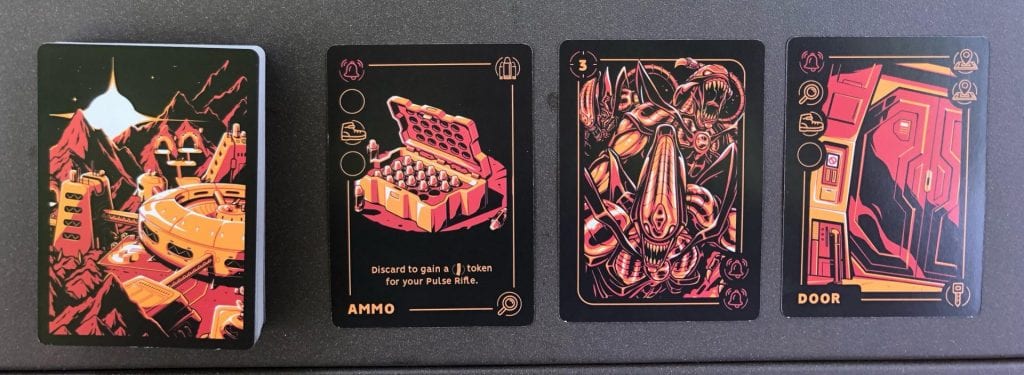
A Brand New Colony
The specific mechanic of Mining Colony 415 is a dexterity test in which the player physically throws cardboard tokens at a target. At the start of the game, the target card is placed inside the lid of the game’s box. This card is double-sided, with a large circle on one side (for an easier game) and a small square on the other (for a harder one). The lid is then placed flat on the table in the space above the Hunted and Location decks.

Whenever a test is needed, the player tosses one or more tokens simultaneously. Any tokens which land on or inside the bounded area count as a success. Most tests require only a single success. Tokens come in a variety of shapes and sizes; the token(s) used can change based on the player’s performance in the game. For example, the player uses a larger token for tests when at full Health and a smaller one once they’re below half of their starting Health, making tests potentially harder based on the outcome of previous actions.
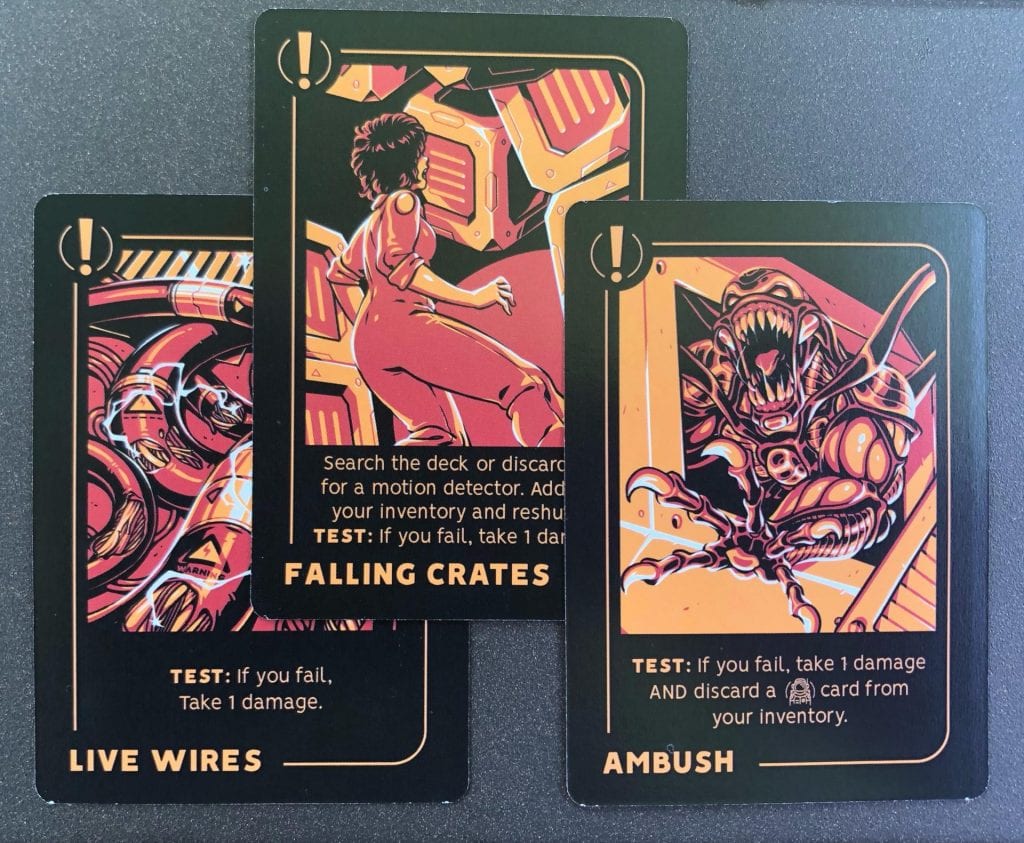
Combat is resolved using the same testing mechanic. However, each alien requires between 1 and 3 successes to defeat based on their strength. Players start with a basic pulse rifle containing 4 shot tokens. They may also acquire more advanced weaponry — such as the grenade launcher and its very large token — throughout play.

During each round of combat, the player spends 1 Time to fire their weapons, throwing any number of their available shot and/or grenade tokens simultaneously. If they reach the required number of successes they defeat the alien, discard it, and return to flipping Hunted cards. If they fail they lose 1 Health and must try again. The player can refill their shots to the weapon’s maximum (4 for the pulse rifle) at any time by reloading; this costs both an ammo token and 1 Time. The default rifle has 3 ammo tokens to start, so there are a limited number of reloads available. The player loses the game if they run out of Health or Time or are completely unable to make an attack during combat.
One of the cleverest aspects of this combat system is the balance between throwing enough tokens to defeat the threat quickly and few enough that they all land accurately. Players must manage their Time and Ammo wisely as well. Reloading too early can waste Time and shots while each missed attempt cuts into the player’s limited Health. Finding this balance adds a much-needed strategic element to the game.

Mine, All Mine!
I picked Mining Colony 415 up on a whim after seeing it mentioned a few times online. The Alien-inspired theme and art seemed interesting enough; more than that, I was curious about the solo dexterity experience. (Though it does have a 2-player cooperative mode, I only played it solo.) Part of the appeal of dexterity games — in my opinion — is the joy of playing them with others. It’s a communal experience where players can laugh at each other’s misfortunes or cheer an unbelievable inversion of physics. Could a solo dexterity game really add enough of that zest to be worthwhile?
I opened Mining Colony 415, set it up, and played my first game. When it ended, I played another. Then another. I couldn’t stop. In all I played 5 games in a single evening and would have gladly played a few more if bedtime hadn’t arrived. The next evening I played another handful and promptly ordered the other Hunted game currently available, Kobayashi Tower. I was hooked.
Mining Colony 415 is a surprising amount of fun. It’s just absurdly more-ish, with its steady drip of small choices punctuated by the occasional flood of endorphins from a well-placed toss. Games rarely take longer than 20 minutes and resetting takes less than 5 so the action never really stops. It’s tense, too: once there’s more than a card or two in the Hunted row, each new draw feels like it could shatter your plans with all the bluntness of a grenade. Watching your resources and tokens dwindle contributes to the sense of looming danger. Wins are rare enough that they feel good without being so rare that the game feels impossible.
And of course there are the tests: as the game relentlessly pushes forward, every single test takes on the seriousness of a free throw in the waning seconds of a tied NBA Finals. I’d stop and take a deep breath to steady myself before throwing my token a mere 9 inches. It sounds foolishly simple; I can assure you that it’s much harder than it seems. I’d groan audibly with each miss and pump my fist with every lucky bounce. I didn’t mind not having another player there. To be honest, I’m not sure I’d want to have a partner. There’s something about having to make each throw myself that captures the lonely hopelessness of the theme.
Though Mining Colony 415 wears out its welcome eventually, that point takes longer to reach than you might expect. There’s just enough variability here that each game feels fresh yet familiar. Knowledge of the cards can help players make better strategic choices; muscle memory can help players make better tosses. There are a few variations on difficulty beyond Normal/Hard to test even skilled players. Pushing the difficulty higher and higher has diminishing returns, however. In theory players can track their high score across sessions, but in practice the joy comes from winning the game at all. Once I had a handful of hard-earned wins under my belt I was happy to set the game aside for a while — though I know I’ll be back before too long.

With all that said, I do have to criticize one aspect of the production: the rulebook. There are a couple key areas where the rules are not entirely clear for a new player. For example, nowhere does it state in words which icons on a card are spent and which are the cost. To fully understand how to play I had to squint at a murky, hard-to-read graphic. Considering that this is the core of not just this one game but a whole series, it feels woefully insufficient.
Similarly, the tests in this game rely on determining whether a token lands on or inside the boundary areas. There’s no guidance on what happens when a token lands so that its edge is touching a line without obscuring it, a situation which comes up fairly often. There’s no mention of what happens if the player misses the box entirely which NEVER HAPPENED TO ME. I assume that it counts as a miss and does not merit a re-toss, but it would be nice to know for sure just in case. There’s no rule stating whether players can reload their weapon during combat (they can) and whether that counts as a combat round or not for the purposes of taking damage from enemies (it doesn’t). I played the first few games at a significant disadvantage, thinking I had to constantly keep my gun full to even have a chance at surviving a single combat.
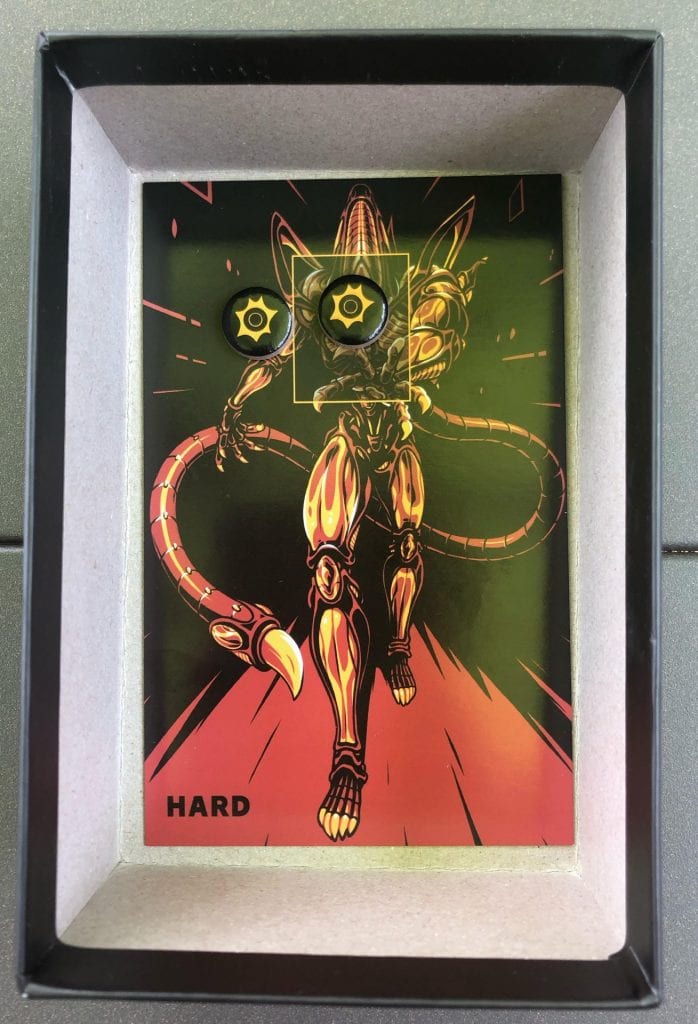
That didn’t really dampen my enthusiasm for Mining Colony 415. Losing a few minutes to the rulebook’s inscrutability is nothing compared to the enjoyment I got out of the game. It’s light, quick fun that keeps you on the edge of your seat the whole time — and not just to get closer to the target! If you’re a casual solo gamer or just a sci-fi fan, you’ll want to give Hunted: Mining Colony 415 a shot.


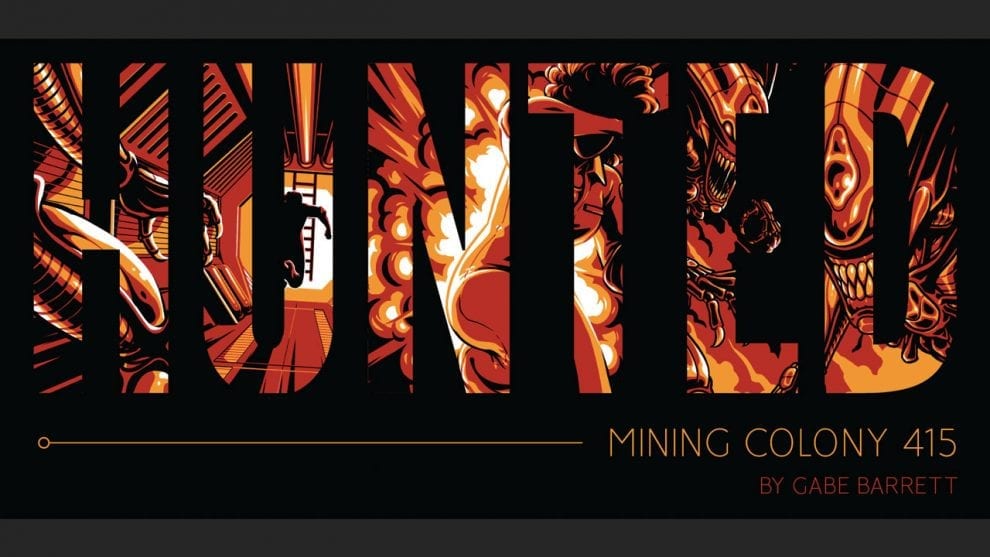

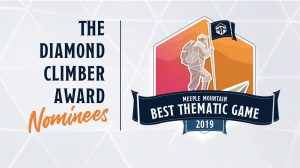







Add Comment